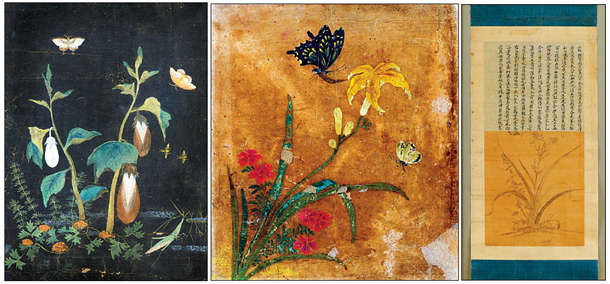A fresh look at Saimdang : Exhibit of the Joseon-era female painter highlights her standing among scholars

Two chochungdo, or paintings of plants and insects in rich color, left and above, and mungnando, or a painting of an orchid in black ink, were created by Saimdang (1504-51). An exhibition that sheds new light on the 16th-century Korean female painter and poet started last week at Seoul Museum in Buam-dong, central Seoul. [SEOUL MUSEUM]
The exhibition, titled “Saimdang, Her Garden,” also celebrates the fifth anniversary of Seoul Museum, located in Buam-dong in central Seoul. The show features 15 paintings by the artist among the museum’s collection - 14 pieces of colorful chochungdo and one piece of black-ink mungnando.
Chochungdo is a painting genre that depicts plants and insects elaborately in rich colors, whereas mungnando is a painting genre that depicts orchids painted with black ink in simplified forms, as part of muninhwa, which refers to philosophical paintings by scholars.
“The exhibits show Saimdang was excellent in both genres,” explained Ahn Jin-woo, a team manager of Seoul Museum. “And we intend to let the viewers know the fact that her paintings were highly appreciated by male scholars, even in the extremely-patriarchal Joseon period [1392-1910].”
The museum has installed panels with excerpts from the reviews of her paintings by Joseon writers of the 16th to 19th centuries.
One of them reads “Her landscape paintings and still lifes, in particular those of grapes, are so exquisite that the viewers say she is second only to An Gyeon [regarded as the greatest painter of the early Joseon period.] So how can we ignore her paintings for the reason that they are works by a woman and how can we blame her for doing works not suitable for women?”
According to another of the panels, King Sukjong (1660-1720) wrote that he loved her paintings as “the plants and insects are so realistic” and had a court painter copy several pieces of her paintings to decorate a folding screen.
Among the exhibits, chochungdo, in particular those painted on gamji, or papers dyed dark blue, look very modern, as the shapes are formed by only coloring without outlines and the contrast of the colors are strong. “It is very difficult to paint without outlines, and Joseon critics highly praised the techniques,” Ahn said. “With the works, we want to show Saimdang as an artist rather than the model of ‘wise mother and good wife.’”
Saimdang appears on the Korean 50,000-won banknote. When the banknote was introduced in 2009, it was met with some controversy. Some said she won fame mainly thanks to her son, the important Confucian scholar Yulgok, so she was not qualified to be on the bill.
Even some feminist groups opposed Saimdang’s appearance on the banknote, saying that she is known mainly as the wise mother of Yulgok, so she could not inspire contemporary women and she should be replaced with a more independent female figure.
“The controversy came because the late Joseon scholar-officials including Song Si-yeol worshipped Yulgok and emphasized Saimdang as a wise mother,” novelist Lee Sun-won said in a recent interview with the JoongAng Ilbo. He recently released a historical novel about Saimdang, after researching many historical documents.
“This image became more prevalent in the 20th century,” he continued. “But she was famous as an artist before her qualities as a wise mother was magnified. She was an excellent artist and writer and for that reason, she is qualified enough for the banknote figure.”
BY MOON SO-YOUNG [symoon@joongang.co.kr]
Admission is 9,000 won ($7.79) for adults and includes admission to the other shows going on at the museum and to Seokpajeong, the summer residence of King Gojong’s father, behind the museum. The museum is closed on Mondays. Take bus Nos. 1020, 1711, 7016, 7018, 7022 or 7212 to the Jahamun Tunnel stop.
For details, visit www.seoulmuseum.org or call (02) 395-0100.










with the Korea JoongAng Daily
To write comments, please log in to one of the accounts.
Standards Board Policy (0/250자)